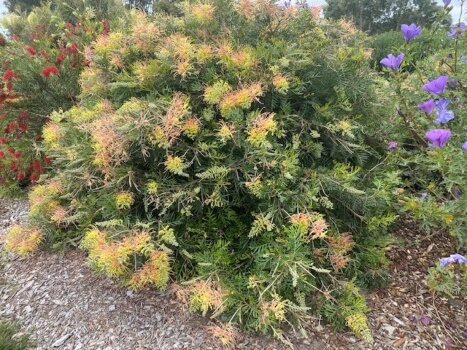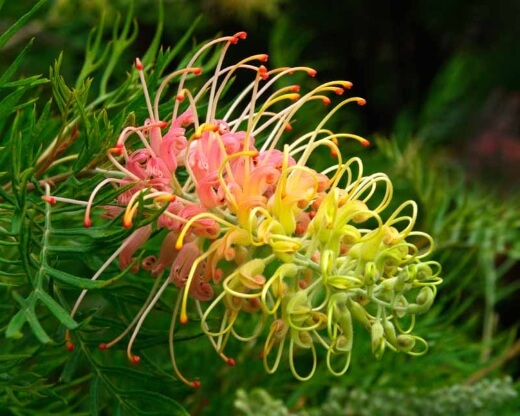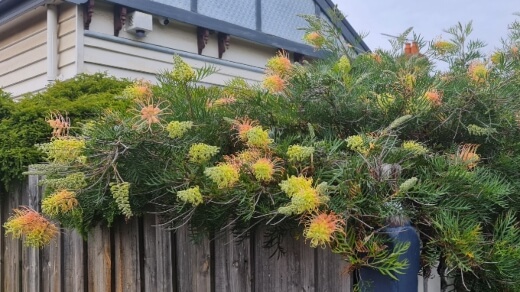The name Grevillea ‘Peaches and Cream’ probably creates the right impression of a seriously good looking shrub – imagine flowers that look almost edible because the colours are just divine. You might also have been thinking about dessert, in which case we can’t help you here.
In our how to grow and care guide, we’ll officially introduce you to this lovely cultivar. We’ll talk about Grevillea ‘Peaches and Cream’ propagation and plant care, and pests and diseases you will need to look out for.
More...
Family: | Proteaceae |
|---|---|
Genus: | Grevillea |
Hybrid: | Grevillea banksii x Grevillea bipinnatifida |
Common Name: | Grevillea ‘Peaches and Cream’ |
Location: | Outdoor |
Type: | Shrub |
Height: | Up to 1.8 metres |
Spread: | Up to 1.8 metres |
Sun requirements: | Full sun, partial sun |
Foliage Colour: | Bright green, bronze |
Flower Colour: | Yellow, pink, orange |
Flowering: | Year round |
Fruit: | None |
Maintenance level: | Low |
Poisonous for pets: | Yes |
Introducing Grevillea ‘Peaches and Cream’

Source: gardensonline.com.au
Grevillea ‘Peaches and Cream’ is a Grevillea hybrid that has become incredibly popular and is native to Australia. It’s a type of evergreen shrub that blooms all year round.
The flowers actually change in colour as they mature, starting off yellow and then becoming pink and orange, hence the name peaches and cream.
The Grevillea ‘Peaches and Cream’ produce plenty of nectar which birds absolutely love, hummingbirds in particular. The shrub leaves are bright green but also have a hint of bronze on the tips during the wintertime.
This really is one good looking shrub. Grevillea ‘Peaches and Cream’ does well in a whole range of climates, whether dry or humid. It can handle frost and almost any type of soil.
The parents of this particular hybrid are the Grevillea bipinnatifida which comes from Western Australia, and Grevillea banksii, from Queensland. The Grevillea ‘Peaches and Cream’ cultivar was first spotted in Brisbane in 1997 and became an official variety in 2006.
The shrub is versatile because you can grow it in acidic soil, as long as it’s well-draining, and the plant will do well in either full sun or partial shade. Once this Grevillea has matured it can handle drought well.
Grevillea ‘Peaches and Cream’ looks great as a hedge or screen and is effective as a windbreak. If you’re living by the coast, the shrub will do well.
You need to practice some caution as with any Grevillea because it can irritate your skin if you are sensitive.
How to Grow Grevillea ‘Peaches and Cream’ in Australia
If you’re the kind of gardener who is looking for a low maintenance shrub, you’ll be in good company with the Grevillea ‘Peaches and Cream’. The shrub flowers for long periods and the birds love them.

Source: gardenfeast.com.au
Let’s look at some tips for keeping your shrub happy and healthy:


Get Your Free Guide:
Master Growing Australian Natives eBook
A Must Have Complete Guide for Every Australian Garden
Get Your Free Guide:
Master Growing Australian Natives eBook
A Must Have Complete Guide for Every Australian Garden
Sunlight Needs
Grevillea ‘Peaches and Cream’ likes lots of sun so aim for a sunny spot in the garden. They can do shade but you might then notice less flowers on your shrub.
There are other Grevillea varieties that do better in shade so if you don’t have a lot of sunlight to offer, you can research other cultivars that might work.
What Soil to Use
True to its low maintenance reputation, the Grevillea ‘Peaches and Cream’ can handle most types of soil. A well-draining soil is always preferable though. If the soil in your garden is more clay, you can break it up into smaller parts before you plant your shrub.
The Grevillea ‘Peaches and Cream’ will also appreciate a soil that has some organic matter and mulch added to the mix.
Propagation of Grevillea ‘Peaches and Cream’

Source: davesgarden.com
Propagating Grevillea ‘Peaches and Cream’ Using Cuttings
You can quite easily propagate your own Grevillea ‘Peaches and Cream’, either using seeds or cuttings. If you’re going the cutting route, it should be during winter or early spring.
You’ll want to select a shoot that has a soft tip or is semi ripe and aim for a length around 10cm. Take the leaves off the lower half of the cutting and try not to damage the bark. If you see any flowers or little stems, you can remove these as well.
You can prepare a container with some coarse sand, dip the cut end into a rooting hormone and then plant it. Give a little bit of water and then place the container somewhere warm but it shouldn’t be directly in the sun.
You can spray mist the cuttings quite often to maintain moisture levels. Practice some patience as your cutting can take as much as 6 months before it grows roots.
Growing from seeds
A good time for propagating with seed is either early in the spring, or late in the summer. The seeds of the Grevillea ‘Peaches and Cream’ are contained in a type of wood pod.
In order to extract the seed, you could place the pods in a paper bag and store them somewhere warm and dry. Usually within a few days, the seed should have been released from the pods.
If this doesn’t work, you can also pop the wooden pods into the oven on a very low heat to get them to open up. We advise using fresh seed whenever possible.
This will better the chances of germination. Place each seed in a layer of moist cotton wool and when you first notice signs of growth, you can plant the seed in a well-draining sand or soil mixture.
You’ll need to place your seedlings container/s somewhere that has good lighting but not direct sunlight and be careful not to give it too much water.

Planting the New Seedling
When your seedling is looking good and strong and ready for life in the ground, you can dig a hole about one and a half wider than the container it has been living in. When you pop it into the ground you want to make sure that the top of the root ball is the same level as the ground.
Before you plant your seedling, it’s a good idea to put your Grevillea ‘Peaches and Cream’ in some water so the entire plant is wet. This gives the plant a boost as it begins to grow in its new home.
Another helpful tip is to pinch off the tips of the plant – this helps the shrub grow nice and bushy and it will produce more flowers too!
Give plenty of water to your plant once in the ground and we recommend adding some mulch around the base of the seedling. Adding a low phosphorus fertiliser to the soil is also guaranteed to keep your growing seedlings happy.
The mulch will help to lock in moisture but also helps with weed control. Your new plant is going to need water often and if it’s windy and hot, let this also guide you.
If you’ve fallen in love with Grevilleas and want to know more about this amazing Australian native, have a look at our Grevillea gardener’s guide for growing this garden favourite.
Grevillea ‘Peaches and Cream’ Care Tips
Watering Grevillea ‘Peaches and Cream’
Once you’ve established your Grevillea ‘Peaches and Cream’, it will be able to handle dry spells. Of course, everything grows better (and makes more beautiful flowers) with some water to drink so if you do have water available for your plant, rather top it up.
As the seasons change, the temperatures drop and perhaps more rainfall arrives, you can start to cut back on your watering schedule.
When you’ve just planted your Grevillea ‘Peaches and Cream’, a good guideline is to water the plant twice a week for around 3 weeks. You can then cut down to once a week for a month.
After this initial period, you can then use the weather as your guide for how often your shrub needs water.

Source: gardensonline.com.au
What Fertiliser to Use
When you move into the warmer seasons, you can treat your Grevillea ‘Peaches and Cream’ to a low phosphorus fertiliser. Grevilleas don’t do well with phosphorus so choosing the right kind of fertiliser is really important.
We recommend a special native fertiliser that has a sustained release.
Pruning Peaches and Cream Grevillea
Some plants love a good pruning and the Grevillea ‘Peaches and Cream’ is one of these. A good time to prune is during the springtime and usually the shrub responds with even more flowers.
If you are planning to prune at other times of the year, you can stick to the warm months. Often gardeners like to prune to maintain a certain shape for their shrub.
Common Pests and Diseases to Look Out For
Scale
Where there is a Grevillea ‘Peaches and Cream’ there is bound to be an issue with scale. This is a pest common to the shrub. The way these insects work (they are tiny by the way) is that they suck sap from the plant and then leave behind a sticky substance.
It’s this stickiness that then causes sooty mould to develop, a black fungus which can then actually harm your plant. If you want to get rid of the scale, you can use your fingers to rub them off the leaves.
Once you’ve done this, you can then spray with something like neem oil which will help to get rid of any leftover scale. Once you clear up the scale insects, it takes care of the sooty mould as well.
Root rot
You’ll know you’re dealing with root rot if the roots of your shrub are soft and brown instead of strong and white. This usually happens if the plant is living in soggy soil.
This is the perfect breeding ground for fungal spores and as they spread, they take over the roots first. Root rot means that the plant won’t be able to absorb nutrients and you start to notice the leaves will wilt and become yellow.
They might even start falling off. If you’re dealing with a really severe case of root rot, it’s possible for the plant to die within 2 weeks. If you’ve diagnosed the problem as root rot, you’ll need to make a call about the plant and whether it can make it.
If the whole of the root system is soft and squishy it’s unfortunately too late. If you spot some white on the roots, then there is still a chance. You can replant the shrub in fresh soil and once again, ensure that it has good drainage.
You’ll first need to prepare the plant by cleaning the roots in running water. Make sure you get rid of any brown and squishy root attached using scissors and then replant as soon as possible. Be sure to sterilise your scissors after the process.
Mealybugs
Mealybugs are tiny pests that actually look a bit like cotton on the leaves and stems of a plant. Like scales, they suck sap out of the plant tissue but don’t cause too much damage if the infestation is minimal.
If you’re dealing with a big infestation, you might notice that the leaves turn yellow and start to curl. The mealybugs leave behind a sticky substance which again causes sooty mould.
You can prune off parts of the plant that are affected and use rubbing alcohol to clean off the leaves. Neem oil is great to use because it actually affects the growth and development of mealybugs and is kind to the environment too.
Grevillea ‘Peaches and Cream’ FAQs

Source: gardenworld.com.au
Did the Aborigine people use the Grevillea for any food or medicinal purposes?
The flowers of the Grevillea were very much loved by the Aborigine people who enjoyed the sweet nectar of the flowers. The nectar would either be shaken out or enjoyed as is, or it was mixed with water to make a drink.
Where does the name Grevillea and the Peaches and Cream cultivar get its name from?
The name Grevillea is after Charles Francis Greville who was an 18th century patron of botany. He also co-founded the Royal Horticultural Society. ‘Peaches and Cream’ is the name that was chosen to describe the mixture of colours of the shrub’s flowers.
How long can a Grevillea live for?
This lovely shrub can live as long as 65 years.
In the mood for more gardening reading and advice? Check out our newsletter for plant profiles, advice on everything from tools to fertiliser, and even some inspiration for the smallest garden.
Are you fond of growing more grevilleas? See our list below for more cultivars to grow in your home.
Brighten Up Your Garden by Growing Grevillea ‘Peaches and Cream’
Grevillea ‘Peaches and Cream’ will certainly brighten up any garden with its gorgeous blooms that seem to go on and on forever. Even the leaves are pretty!
The low maintenance shrub doesn’t ask for much in terms of care, but will make a great feature or hedge, and of course the birds it attracts make a garden even lovelier.
You can propagate the shrub with ease and it doesn’t struggle with major pests and disease. We think you’ll be very happy together and we’re giving the charming Grevillea ‘Peaches and Cream’ our green thumbs up.
Published on September 22, 2022 by Nathan Schwartz
Last Updated on February 22, 2025




